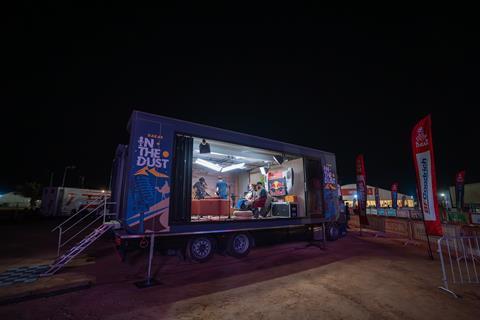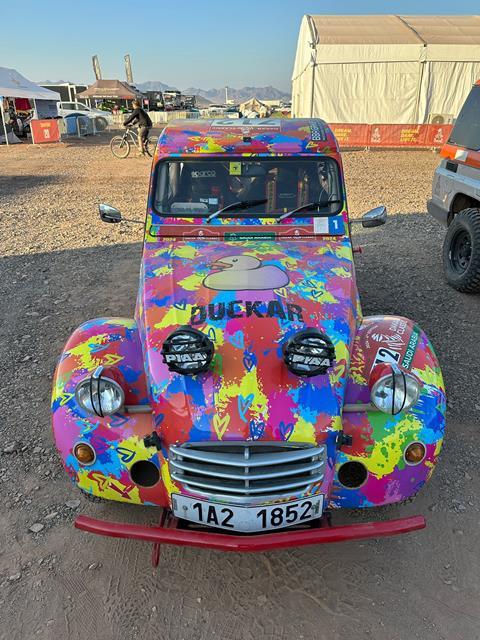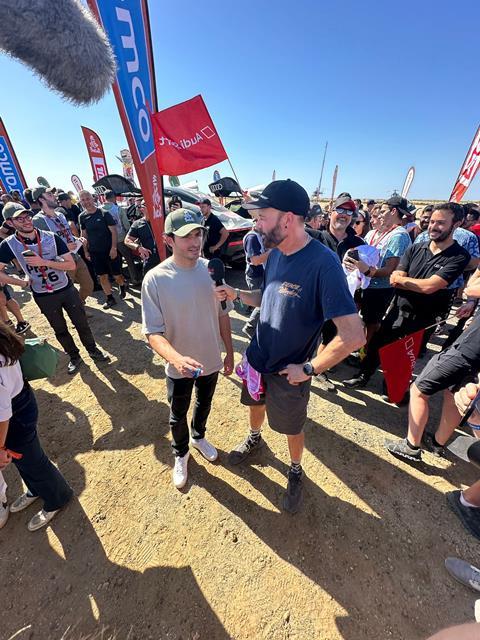The challenges of producing a daily magazine show from a mobile studio travelling across a desert for 10 days

A daily studio-based show called ‘In The Dust’ was introduced to Red Bull’s Dakar Rally coverage (5-19 January) this year. It looked beyond the race result each day to tell the raw, honest Dakar Rally story.
The eight-part series, which was also available as a podcast, saw presenters Nicola Hume and Matt Jones in a different desert location each day as it followed the rally around each stage.

The pair interviewed athletes taking part in what’s described as “the world’s toughest race”, revealing untold stories from the rally from a roving studio.
The rally took place in Saudi Arabia with participants taking part in 7,900km of racing through the desert. It’s considered one of the most gruelling motorsports competitions in the world.

Red Bull introduced In The Dust to try to broaden the appeal of the race to a wider audience. The ambitious setup for the show required a mobile studio to move from stage to stage with a small crew. They would derig at the end of each day and travel through the night to the next location, ready to do the same again the next day.

In The Dust was recorded ‘as live’ with several VTs also prepared for each day’s show. A dedicated satellite slot was provided from the desert to upload each episode, before the studio was packed up and the crew and studio moved across hundreds of miles of the desert to the next stage.
The production was the idea of Glasgow-based Cut Media, which pitched the concept to Red Bull, after being approached by the energy drink/action sport brand. Cut Media Founder and CEO Stuart Thomson told Broadcast Sport: “In The Dust was pitched as a ‘social-first’ studio show that would be filmed in camp each night. The rally travels hundreds of kilometres each day and the camp moves with it.

“The show provided chat about the race as well as highlights and insights into everything going on at Dakar each day. As well as following the well-known athletes, we focused on quirky stories we came across, such as the journey of a 2CV taking part in the rally. It was about following rivalries and navigating the stories as they happened in the desert.”
Cut Media shot eight shows over the duration of the rally.
“We were really delighted to get the commission,” says Thomson. “We’re well known for action footage, and this was a studio format in a difficult environment. Being able to do the social-first format worked really well.”

Scott Marshall, CCO at Cut Media, was part of the team out in Saudi Arabia. Broadcast Sport spoke to him a few days after his return to the UK.
“A crew of just six of us travelled around the desert to shoot the magazine show,” he said. “We created VTs and recorded the show interviewing the athletes and dropping in race highlights from each stage.
“No one has ever brought a studio to Dakar before, so it was a complete unknown. Red Bull had covered the rally for years and had previously put out daily highlights, but they wanted to do something different this time around, with on-the-ground news and daily stories from the race.”

Cut Media was one of five agencies to pitch for the work. Its pitch used the explosion of video-based podcasts over the last few years as inspiration.
Cut Media worked with Dutch company Movico to create the mobile studio and production space.
Marshall said the inspiration for the show was “taken a bit from the way the FA does its content around events such as the World Cup, with studio shows like Lionesses Live. The key difference is this one had to move every day.”

The decision about which stories to focus on was made each day, ahead of the athletes finishing the stage. Cut Media wanted to focus on the athletes in contention for winning while also uncovering unique stories from other participants in the race.
“We had really good stories and themes and each day made a wish list of the stories to tell. It was a balance between serving audiences that had been to Dakar for years and years and trying to get a new audience to get involved,” says Marshall. “We wanted to open up that sense of adventure. We weren’t planning to get into the nitty, gritty of spark plugs and tyres, but wanted to find and follow the stories of Dakar. This meant everything from following high-profile athletes like Carlos Sykes to following a humble 2CV around the rally. This helped us move away from what had been told in the past.”

The process each day was, arrive in the new location; shoot the intros and VTs; create the wish list for post-race interviews; prep hosts; edit the previous night’s shoot; drop in the action footage.
By mid-afternoon, the edit would need to be completed, checked, rewatched and prepped for satellite playout. The satellite links were ready to transmit the edit to Australia at around 7:25pm each day, where it would be captured in real-time at Red Bull, and one hour later it was shown on Red Bull TV. Social media assets, also supplied by Cut Media, would also be distributed across the different platforms.

Meanwhile, at 7pm each day, the athletes would join the In The Dust presenters in the mobile studio and Cut Media would shoot with them for about an hour. The editor would then move to the production bus and start ingest and cutting.
“We worked, slept, cooked and ate on that bus, it was like a tour bus,” laughs Marshall. “After the shoot, the crew would start breaking down the studio ready for a 10pm departure. We would travel through the night, wake up, arrive the next morning at the next camp having grabbed whatever sleep we could on the journey.”

The feedback from Red Bull on the inaugural In The Dust series has been very positive and it has helped it grow awareness of the Dakar rally to a new audience. “The series has also given Red Bull that evergreen content to use for the rest of the year and during the build up to 2025,” adds Marshall.









No comments yet